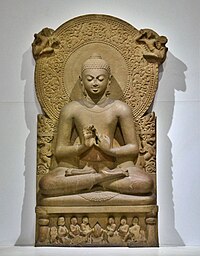ბუდისტური ფილოსოფია: განსხვავება გადახედვებს შორის
| [შემოწმებული ვერსია] | [შემოწმებული ვერსია] |
შიგთავსი ამოიშალა შიგთავსი დაემატა
გადარჩენა 1 წყაროების და მონიშვნა 0 მკვდრად.) #IABot (v2.0.8 |
გადარჩენა 1 წყაროების და მონიშვნა 0 მკვდრად.) #IABot (v2.0.8.1 |
||
| ხაზი 7: | ხაზი 7: | ||
* {{Citation |last=Anderson |first=Carol |year=1999 |title=Pain and Its Ending: The Four Noble Truths in the Theravada Buddhist Canon |publisher=Routledge}} |
* {{Citation |last=Anderson |first=Carol |year=1999 |title=Pain and Its Ending: The Four Noble Truths in the Theravada Buddhist Canon |publisher=Routledge}} |
||
* {{Citation |last=Bronkhorst |first=Johannes |year=1993 |title=The Two Traditions Of Meditation In Ancient India |publisher=Motilal Banarsidass Publ.}} |
* {{Citation |last=Bronkhorst |first=Johannes |year=1993 |title=The Two Traditions Of Meditation In Ancient India |publisher=Motilal Banarsidass Publ.}} |
||
* {{Citation|last=Capriles |first=Elías |title=The Four Schools of Buddhist Philosophy: Clear Discrimination of Views Pointing at the Definitive Meaning |url=http://webdelprofesor.ula.ve/humanidades/elicap/en/uploads/Biblioteca/philosophical_schools.pdf |deadurl=yes |archiveurl=https://web.archive.org/web/20110717191150/http://webdelprofesor.ula.ve/humanidades/elicap/en/uploads/Biblioteca/philosophical_schools.pdf |archivedate=17 July 2011 }} |
* {{Citation |last=Capriles |first=Elías |title=The Four Schools of Buddhist Philosophy: Clear Discrimination of Views Pointing at the Definitive Meaning |url=http://webdelprofesor.ula.ve/humanidades/elicap/en/uploads/Biblioteca/philosophical_schools.pdf |deadurl=yes |archiveurl=https://web.archive.org/web/20110717191150/http://webdelprofesor.ula.ve/humanidades/elicap/en/uploads/Biblioteca/philosophical_schools.pdf |archivedate=17 July 2011 }} {{Webarchive|url=https://web.archive.org/web/20110717191150/http://webdelprofesor.ula.ve/humanidades/elicap/en/uploads/Biblioteca/philosophical_schools.pdf |date=17 ივლისი 2011 }} |
||
* {{Citation |last=Cousins |first=L. S. |year=1996 |title=The dating of the historical Buddha: a review article |journal=Journal of the Royal Asiatic Society |series=3 |volume=6 |issue=1 |pages=57–63 |url=http://indology.info/papers/cousins }} {{Webarchive|url=https://web.archive.org/web/20110226184207/http://indology.info/papers/cousins/ |date=2011-02-26 }} |
* {{Citation |last=Cousins |first=L. S. |year=1996 |title=The dating of the historical Buddha: a review article |journal=Journal of the Royal Asiatic Society |series=3 |volume=6 |issue=1 |pages=57–63 |url=http://indology.info/papers/cousins }} {{Webarchive|url=https://web.archive.org/web/20110226184207/http://indology.info/papers/cousins/ |date=2011-02-26 }} |
||
* {{Citation |last1=Edelglass |first1=William |last2=Garfield |first2=Jay |title=Buddhist Philosophy: Essential Readings |place=New York |publisher=Oxford University Press |year=2009 |isbn=0-19-532817-5}} |
* {{Citation |last1=Edelglass |first1=William |last2=Garfield |first2=Jay |title=Buddhist Philosophy: Essential Readings |place=New York |publisher=Oxford University Press |year=2009 |isbn=0-19-532817-5}} |
||
20:20, 5 ოქტომბერი 2021-ის ვერსია

ბუდისტური ფილოსოფია — ფიდეისტური იდეალიზმის სახე. იგი გამოირჩევა მნიშვნელოვანი სირთულითა და აბსტრაქტულობით. მეტწილად ბუდისტური მიმართულებები არსებობას მიაწერენ მხოლოდ ბუდას, როგორც — „მოქმედი ძალის“, მსოფლიო წესრიგის განსახიერებას, ხოლო მატერიალურ სამყაროს მიიჩნევენ მოჩვენებად, დჰარმების — სულიერი საწყისის მატარებელი მარადიული უმცირესი ნაწილაკების კომბინაციათა ილუზირებულ გამოვლინებად. ხილული სამყარო, მხოლოდ ადამიანის ცნობიერების ნაყოფია. ბუდისტურ ფილოსოფიაში არის დიალექტიკის ელემენტები, რაც გულისხმობს სამყაროს მუდმივი ცვალბადობის აღიარებას, მოვლენათა მიზეზობრივ კავშირს და სხვა.
ლიტერატურა
- სტატიიდან „ბუდიზმი“, ქართული საბჭოთა ენციკლოპედია, ტ. 2, თბ., 1977. — გვ. 552.
- Anderson, Carol (1999), Pain and Its Ending: The Four Noble Truths in the Theravada Buddhist Canon, Routledge
- Bronkhorst, Johannes (1993), The Two Traditions Of Meditation In Ancient India, Motilal Banarsidass Publ.
- Capriles, Elías, The Four Schools of Buddhist Philosophy: Clear Discrimination of Views Pointing at the Definitive Meaning, http://webdelprofesor.ula.ve/humanidades/elicap/en/uploads/Biblioteca/philosophical_schools.pdf დაარქივებული 17 July 2011[Date mismatch] საიტზე Wayback Machine.Category:Webarchive-ის თარგის შეტყობინებები
- Cousins, L. S. (1996), "The dating of the historical Buddha: a review article", Journal of the Royal Asiatic Society, 3 6 (1): 57–63, http://indology.info/papers/cousins დაარქივებული 2011-02-26 საიტზე Wayback Machine.
- Edelglass, William; Garfield, Jay (2009), Buddhist Philosophy: Essential Readings, New York: Oxford University Press, ISBN 0-19-532817-5
- Gombrich, Richard F. (1997), How Buddhism Began, Munshiram Manoharlal
- Kalupahana, David J. (1992), The Principles of Buddhist Psychology, Delhi: Sri Satguru Publications
- Kalupahana, David J. (1994), A history of Buddhist philosophy, Delhi: Motilal Banarsidass Publishers Private Limited
- Perdue, Daniel (1992), Debate in Tibetan Buddhism, Snow Lion Publications, ISBN 978-0-937938-76-8
- Vetter, Tilmann (1988), The Ideas and Meditative Practices of Early Buddhism, BRILL
